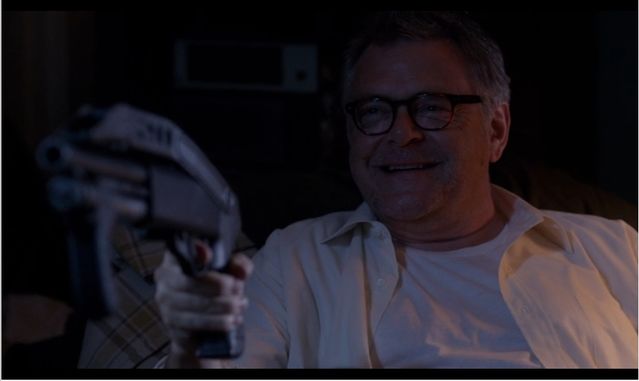Magical Thinking
Decide to Be Fine: A Supernatural Contract to Keep Fighting
Supernatural computer hacker recommends entering no-harm contract with oneself.
Posted October 24, 2017
“I, ____________, agree not to harm myself or anyone else, attempt suicide, or commit suicide for the time period from __________ to __________ (the time of my next appointment).”
—a sample no-harm contract opening based on Fidler (n.d.); TheraNest (n.d.); Yuen (2016).
“Decide to be fine ‘til the end of the week. Make yourself smile because you’re alive and it’s your job. And do it again the next week.”
—computer hacker Frank Devereaux, character on Supernatural TV series played by actor Kevin McNally. Episode 7-11, “Adventures in Babysitting” (January 6, 2012).

Also called a no-suicide decision (Drye et al., 1973), safety agreement (Potter & Dawson, 2001), or suicide prevention contract (Miller, 1999), the no-harm contract is a potentially-suicidal individual’s promise to commit no self-harm for the time being. Contracting for safety in this way is a popular counseling technique even though it has been used in so many ways with so little methodical study that investigators disagree on its effectiveness (Clark & Kerkhof, 1997; Edwards & Sachmann, 2010). One critical factor is that the individual must not feel coerced into this commitment (Caruso, n.d.; McMyler & Pryjmachuk, 2008). A professional suggesting it should do so gently by pointing out its importance. Some counselors let clients write their own no-harm pledges, which might help them feel more empowered and dedicated (Keiser & Grossman, 2016; Pfeiffer, n.d.; see also Wallace, 2016).
The television series Supernatural once featured a recurring character, computer hacker Frank Devereaux, who essentially describes having made a non-harm contract and recommending that another character consider doing so, too. Whether Frank originally enters into that contract with a therapist or only with himself, viewers do not know. After his family’s murder, Frank Devereaux makes this choice, perhaps on his own initiative or perhaps after a professional who has supposedly diagnosed him as “bipolar with delusional ideation” offers the idea. However he comes to make his no-harm decision during his twenties, Frank still renews it week after week in middle-age to keep going and always keep fighting.
Most of us who know both the show and the character well also know Frank faked his death because of Frank's obsessively cautious (paranoid, as several characters put it) and the lead characters, the Winchesters, are dangerous to be around. Frank just went deeper off the grid, his own way to keep fighting.
“There’s no shame in having to fight every day, but fighting every day—and presumably if you’re still alive to hear these words or read this…then you are winning your war. You’re here.”
—Always Keep Fighting founder Jared Padalecki

Related Posts:
- Haunted by Sigmund Freud: Adaptation or Defense Mechanisms?
- Grief out of Order: Apocalyptic Loss and "The Walking Dead"
- Superhero Therapy: Fears Do Not Make Heroes Any Less Heroic
- Doctor Who: "Listen" to Your Fear
- Guidelines for Covering Suicide: How Many Have We Violated?
- Spectacular Tragedy in a Just World: The Power of "Why?"
Excerpt from the book Supernatural Psychology: Roads Less Traveled (Langley, 2017).
References
Caruso, K. (n.d.). No-suicide contracts—what they are and how you should use them. Suicide.org: http://www.suicide.org/no-suicide-contracts.html.
Clark, D. C., & Kerkhof, J. F. M. (1997). No-suicide contracts and no-suicide decisions. Crisis: The Journal of Crisis Intervention & Suicide Prevention, 18(1), 2.
Drye, R., Goulding, R., & Goulding, M. (1973). No-suicide decisions: Patient monitoring of suicidal risk. American Journal of Psychiatry, 130(2), 171-174.
Edwards, S. J., & Sachmann, M. D. (2010). No-suicide contracts, no-suicide agreements, and no-suicide assurances: A study of their nature, utilization, perceived effectiveness, and potential to cause harm. Crisis: The Journal of Crisis Intervention & Suicide Prevention, 31(6), 290-302.
Fidler, B. (n.d.). No harm contract. Brian Fidler Counseling: http://www.brianfidlercounseling.com/userfiles/569378/file/No%20Harm%20….
Keiser, C. C., & Grossman (2016, June 1). Do no harm! Do No Harm: http://www.donoharm.us/.
Langley, T. (2017). Decide to be fine: A contract to keep going. In T. Langley & L. Zubernis (Eds.), Supernatural psychology: Roads less traveled (p. 127). New York, NY: Sterling.
McMyler, C., & Pryjmachuk, S. (2008). Do “no-suicide” contracts work? Journal of Psychiatric & Mental Health Nursing, 15(6), 512-522.
Pfeiffer, K. L., (n.d.). Creating a safety plan. The Sunny Shadow: https://thesunnyshadow.com/creating-a-safety-plan/.
TheraNest (n.d.). Free downloadable forms & templates for counselors & psychtherapists. TheraNest: https://www.theranest.com/free-counseling-note-templates/.
Wallace, D. (2016, January 10). Anger management. Cashman Center: http://cashmancentermn.com/1591-2/.
Yuen, C. (2016, March 15). Psychologists support Education Bureau’s “no suicide” student contracts. Hong Kong Free Press: https://www.hongkongfp.com/2016/03/15/psychologists-support-education-b….


